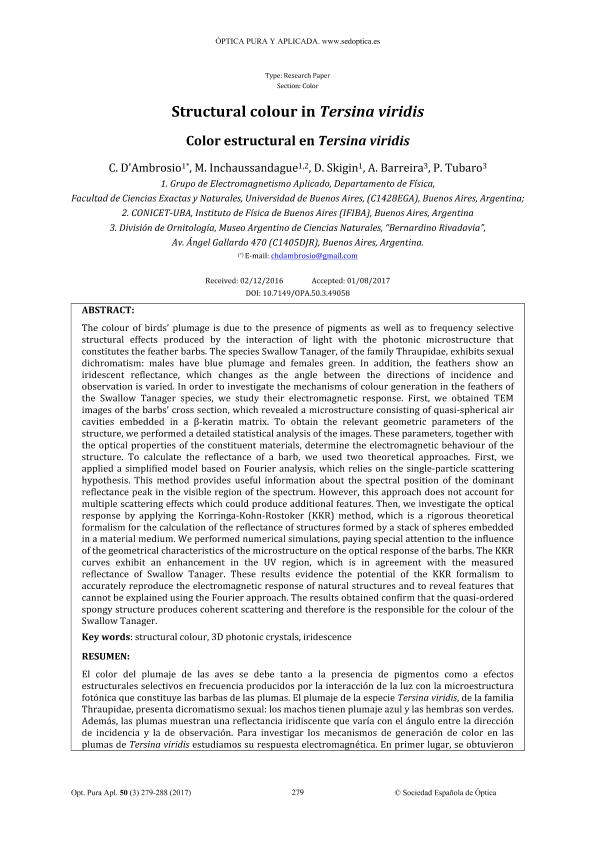Mostrar el registro sencillo del ítem
dc.contributor.author
D'ambrosio, Christian Nahuel

dc.contributor.author
Inchaussandague, Marina Elizabeth

dc.contributor.author
Skigin, Diana Carina

dc.contributor.author
Barreira, Ana Soledad

dc.contributor.author
Tubaro, Pablo Luis

dc.date.available
2018-11-16T16:29:08Z
dc.date.issued
2017-10
dc.identifier.citation
D'ambrosio, Christian Nahuel; Inchaussandague, Marina Elizabeth; Skigin, Diana Carina; Barreira, Ana Soledad; Tubaro, Pablo Luis; Structural colour in Tersina viridis; Sociedad Espanola de Optica; Optica Pura y Aplicada; 50; 3; 10-2017; 279-288
dc.identifier.issn
2171-8814
dc.identifier.uri
http://hdl.handle.net/11336/64606
dc.description.abstract
The colour of birds' plumage is due to the presence of pigments as well as to frequency selective structural effects produced by the interaction of light with the photonic microstructure that constitutes the feather barbs. The species Swallow Tanager, of the family Thraupidae, exhibits sexual dichromatism: males have blue plumage and females green. In addition, the feathers show an iridescent reflectance, which changes as the angle between the directions of incidence and observation is varied. In order to investigate the mechanisms of colour generation in the feathers of the Swallow Tanager species, we study their electromagnetic response. First, we obtained TEM images of the barbs' cross section, which revealed a microstructure consisting of quasi-spherical air cavities embedded in a ß-keratin matrix. To obtain the relevant geometric parameters of the structure, we performed a detailed statistical analysis of the images. These parameters, together with the optical properties of the constituent materials, determine the electromagnetic behaviour of the structure. To calculate the reflectance of a barb, we used two theoretical approaches. First, we applied a simplified model based on Fourier analysis, which relies on the single-particle scattering hypothesis. This method provides useful information about the spectral position of the dominant reflectance peak in the visible region of the spectrum. However, this approach does not account for multiple scattering effects which could produce additional features. Then, we investigate the optical response by applying the Korringa-Kohn-Rostoker (KKR) method, which is a rigorous theoretical formalism for the calculation of the reflectance of structures formed by a stack of spheres embedded in a material medium. We performed numerical simulations, paying special attention to the influence of the geometrical characteristics of the microstructure on the optical response of the barbs. The KKR curves exhibit an enhancement in the UV region, which is in agreement with the measured reflectance of Swallow Tanager. These results evidence the potential of the KKR formalism to accurately reproduce the electromagnetic response of natural structures and to reveal features that cannot be explained using the Fourier approach. The results obtained confirm that the quasi-ordered spongy structure produces coherent scattering and therefore is the responsible for the colour of the Swallow Tanager.
dc.format
application/pdf
dc.language.iso
eng
dc.publisher
Sociedad Espanola de Optica
dc.rights
info:eu-repo/semantics/openAccess
dc.rights.uri
https://creativecommons.org/licenses/by-nc-sa/2.5/ar/
dc.subject
3d Photonic Crystals
dc.subject
Iridescence
dc.subject
Structural Colour
dc.subject.classification
Astronomía

dc.subject.classification
Ciencias Físicas

dc.subject.classification
CIENCIAS NATURALES Y EXACTAS

dc.subject.classification
Astronomía

dc.subject.classification
Ciencias Físicas

dc.subject.classification
CIENCIAS NATURALES Y EXACTAS

dc.title
Structural colour in Tersina viridis
dc.type
info:eu-repo/semantics/article
dc.type
info:ar-repo/semantics/artículo
dc.type
info:eu-repo/semantics/publishedVersion
dc.date.updated
2018-10-23T18:13:06Z
dc.journal.volume
50
dc.journal.number
3
dc.journal.pagination
279-288
dc.journal.pais
España

dc.journal.ciudad
Alicante
dc.description.fil
Fil: D'ambrosio, Christian Nahuel. Universidad de Buenos Aires. Facultad de Ciencias Exactas y Naturales. Departamento de Física; Argentina
dc.description.fil
Fil: Inchaussandague, Marina Elizabeth. Consejo Nacional de Investigaciones Científicas y Técnicas. Oficina de Coordinación Administrativa Ciudad Universitaria. Instituto de Física de Buenos Aires. Universidad de Buenos Aires. Facultad de Ciencias Exactas y Naturales. Instituto de Física de Buenos Aires; Argentina
dc.description.fil
Fil: Skigin, Diana Carina. Consejo Nacional de Investigaciones Científicas y Técnicas. Oficina de Coordinación Administrativa Ciudad Universitaria. Instituto de Física de Buenos Aires. Universidad de Buenos Aires. Facultad de Ciencias Exactas y Naturales. Instituto de Física de Buenos Aires; Argentina
dc.description.fil
Fil: Barreira, Ana Soledad. Consejo Nacional de Investigaciones Científicas y Técnicas. Oficina de Coordinación Administrativa Parque Centenario. Museo Argentino de Ciencias Naturales “Bernardino Rivadavia”; Argentina
dc.description.fil
Fil: Tubaro, Pablo Luis. Consejo Nacional de Investigaciones Científicas y Técnicas. Oficina de Coordinación Administrativa Parque Centenario. Museo Argentino de Ciencias Naturales “Bernardino Rivadavia”; Argentina
dc.journal.title
Optica Pura y Aplicada
dc.relation.alternativeid
info:eu-repo/semantics/altIdentifier/url/http://www.sedoptica.es/Menu_Volumenes/Pdfs/OPA_50_3_49058.pdf
dc.relation.alternativeid
info:eu-repo/semantics/altIdentifier/doi/http://dx.doi.org/10.7149/OPA.50.3.49058
Archivos asociados
